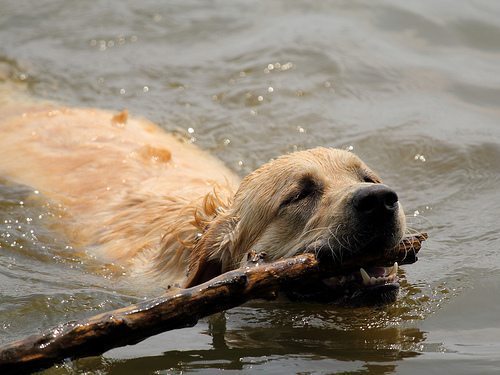AUTHORED BY: Russ Boles and Susan Giordano – K9U Training & Behavior Modification.
All dogs naturally know how to swim, right? Wrong! Depending upon the breed, some dogs are fabulous swimmers, and some cannot swim at all. A few of the breeds that tend to be natural born swimmers are Retrievers, Portuguese Water Dogs, and Poodles.
Not All Dogs Are Great Swimmers
A few of those who are not good swimmers are Dachshunds, Bassett Hounds, Pugs and English Bulldogs. There are other breeds on both ends of this spectrum, and let’s not forget the mixed breed, who may have a lot of Bassett Hound in her, but can swim like a fish, or the Retriever-mix, who couldn’t swim his way out of a kiddie pool.
However, swimming is a great form of exercise for dogs and a great way to have fun with your dog. You simply need to be aware of how to keep everyone safe so a good time can be had by all.
7 Simple Guidelines For Teaching Your Dog How To Swim
If you’re planning a vacation to the beach or the lake that includes the four-legged members of your family, follow these simple guidelines to ensure the most positive outcome of your pet’s first water experience.
1) Get a doggy life jacket for your pet. Even dogs who enjoy swimming can get tired or caught up in a strong undercurrent, and you want your pet to be safe from drowning. Pet life jackets can be purchased at your local pet store or online at www.dogsupplies.com/categories/Aqua-Dog-Supplies/ or at http://www.westmarine.com/buy/popular/pet-life-jackets. Try it on and adjust for fit on your dog before you get to the water. Also, give him a few treats to form a positive association with the life-vest.
2) You should know the area where you plan to swim with your dog; make sure the area is free from sharp rocks or steep drop-offs so your dog doesn’t cut himself or suddenly find himself without solid ground as he ventures into the water.
3) Especially for the first swimming experience, choose a place that is quiet and without many people or other pets.
4) Look out for unsafe pooled water or contaminated water that your dog may try to drink. Have fresh water available for your dog at all times, and be sure he has a chance to get a drink of it before you begin swimming.
5) Never leave your dog unattended in the water. Too many unfortunate things could happen, even to good swimmers wearing life jackets.
6) Be sure your dog knows how to exit the water, whether it’s a swimming pool, the lake or the beach – make sure to show your dog how to get out, and practice several times exiting the water.
7) Always rinse your dog with clean water once the swimming time is over.
Taking your dog to the water
You’ve done your homework, now you are ready to bring your dog into the water. Do not throw him in and hope for the best! Forcing your dog into a large body of water; whether it’s a shallow swimming pool or a lake could be a traumatic experience for your dog, and changing his opinion of the water once he is afraid of it becomes a much more involved and time-consuming task. The best way to get your dog interested in the water is to go in yourself. Do not call him in or coax him; just go in to a shallow area with a family member or friend and start having fun. Toss a ball to each other, laugh and splash around a bit, and simply ignore your dog. Chances are he will want to join in the fun and venture in at this point.
If he does venture towards you, allow him to reach you and praise him for it. Continue to play with him in the shallow water until he has had plenty of time to get used to being wet. Allow him to enter and exit the water at will; do not restrain him so that he is forced to stay in the water. If he chooses to exit right away, start playing amongst yourselves again until he figures out that the party is where you are – not by himself on the sidelines. Let your dog be the one to decide whether or not to enter the water; dogs who figure things out for themselves become more confident, and retain more of what they have learned much faster than if we teach them.
Once your dog is comfortable in shallow water, slowly move to an area where the water is deep enough to require your pet to start swimming, but where you are still able to touch the bottom and stand. Before your dog is too deep to stand, gently put your arms underneath your dog’s belly and allow him to paddle with you supporting him. Do not remove your arms until he is paddling on his own. Of course, he is and has been wearing his life jacket, but you should stay nearby for a while to ensure that he does not panic. If, at any time your dog starts to panic, or appears to be in distress, calmly take control and help him out of the water.
Keep the first swimming experience short and lots of fun, so your dog will look forward to the next time you decide to splash around and have fun.
Photo: Courtesy of Mr. T in DC via Flickr (CC BY-ND 2.0)









